what causes a supply curve to shift left
iii.2 Supply
Learning Objectives
- Define the quantity supplied of a good or service and illustrate it using a supply schedule and a supply curve.
- Distinguish between the following pairs of concepts: supply and quantity supplied, supply schedule and supply bend, movement along and shift in a supply curve.
- Identify supply shifters and make up one's mind whether a change in a supply shifter causes the supply curve to shift to the correct or to the left.
What determines the quantity of a adept or service sellers are willing to offer for sale? Price is one factor; ceteris paribus, a higher cost is likely to induce sellers to offer a greater quantity of a good or service. Production cost is another determinant of supply. Variables that bear upon production cost include the prices of factors used to produce the good or service, returns from alternative activities, applied science, the expectations of sellers, and natural events such as weather changes. Still another gene affecting the quantity of a proficient that will be offered for sale is the number of sellers—the greater the number of sellers of a particular good or service, the greater will exist the quantity offered at whatever price per fourth dimension period.
Price and the Supply Curve
The quantity supplied of a practiced or service is the quantity sellers are willing to sell at a particular toll during a particular period, all other things unchanged. Ceteris paribus, the receipt of a higher cost increases profits and induces sellers to increment the quantity they supply.
In general, when there are many sellers of a practiced, an increase in cost results in an increase in quantity supplied, and this human relationship is often referred to as the law of supply. We will see, though, through our exploration of microeconomics, that there are a number of exceptions to this relationship. At that place are cases in which a higher price will not induce an increase in quantity supplied. Goods that cannot be produced, such as additional land on the corner of Park Avenue and 56th Street in Manhattan, are fixed in supply—a college price cannot induce an increment in the quantity supplied. There are fifty-fifty cases, which nosotros investigate in microeconomic analysis, in which a higher price induces a reduction in the quantity supplied.
Generally speaking, however, when there are many sellers of a good, an increase in price results in a greater quantity supplied. The human relationship between price and quantity supplied is suggested in a supply schedule, a table that shows quantities supplied at different prices during a particular flow, all other things unchanged. Figure 3.8 "A Supply Schedule and a Supply Curve" gives a supply schedule for the quantities of java that will be supplied per calendar month at various prices, ceteris paribus. At a price of $4 per pound, for example, producers are willing to supply 15 million pounds of coffee per month. A college cost, say $6 per pound, induces sellers to supply a greater quantity—25 million pounds of coffee per calendar month.
Figure 3.8 A Supply Schedule and a Supply Curve
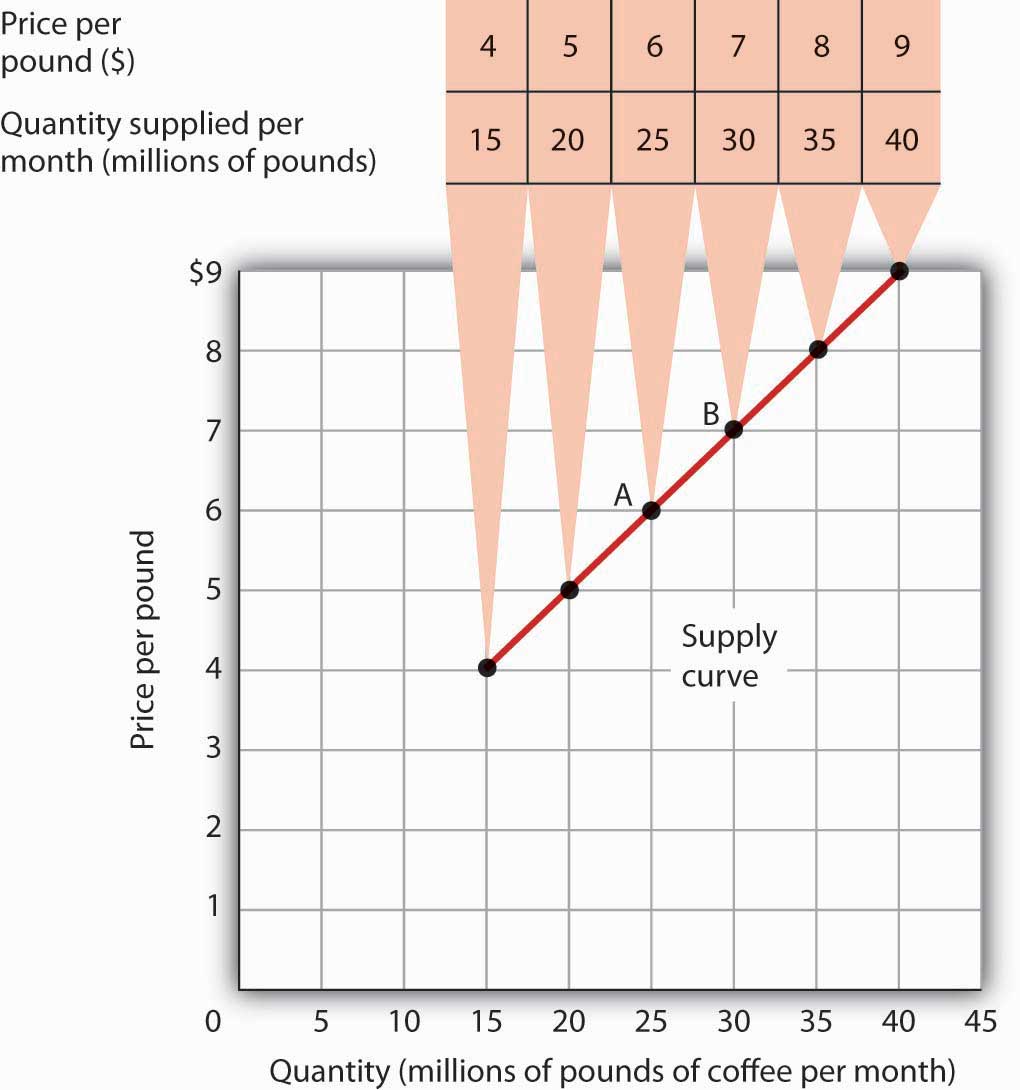
The supply schedule shows the quantity of coffee that will be supplied in the Usa each month at particular prices, all other things unchanged. The same information is given graphically in the supply curve. The values given hither suggest a positive human relationship between price and quantity supplied.
A supply curve is a graphical representation of a supply schedule. It shows the human relationship between price and quantity supplied during a item period, all other things unchanged. Because the relationship betwixt cost and quantity supplied is generally positive, supply curves are generally upward sloping. The supply bend for java in Figure 3.eight "A Supply Schedule and a Supply Curve" shows graphically the values given in the supply schedule.
A modify in price causes a motion forth the supply bend; such a motion is called a change in quantity supplied. As is the case with a change in quantity demanded, a change in quantity supplied does not shift the supply curve. By definition, information technology is a movement along the supply curve. For example, if the toll rises from $vi per pound to $seven per pound, the quantity supplied rises from 25 million pounds per calendar month to thirty million pounds per month. That's a movement from betoken A to point B along the supply curve in Effigy 3.viii "A Supply Schedule and a Supply Curve".
Changes in Supply
When we describe a supply bend, we presume that other variables that touch the willingness of sellers to supply a good or service are unchanged. Information technology follows that a change in whatever of those variables volition cause a change in supply, which is a shift in the supply bend. A change that increases the quantity of a good or service supplied at each cost shifts the supply bend to the right. Suppose, for example, that the toll of fertilizer falls. That will reduce the cost of producing java and thus increase the quantity of coffee producers will offer for auction at each price. The supply schedule in Effigy 3.nine "An Increase in Supply" shows an increment in the quantity of coffee supplied at each price. We evidence that increase graphically as a shift in the supply curve from S ane to South ii. Nosotros come across that the quantity supplied at each price increases past 10 million pounds of coffee per month. At point A on the original supply curve Southward 1, for example, 25 million pounds of coffee per month are supplied at a cost of $half-dozen per pound. After the increment in supply, 35 million pounds per calendar month are supplied at the aforementioned toll (indicate A′ on curve South 2).
Figure 3.ix An Increment in Supply
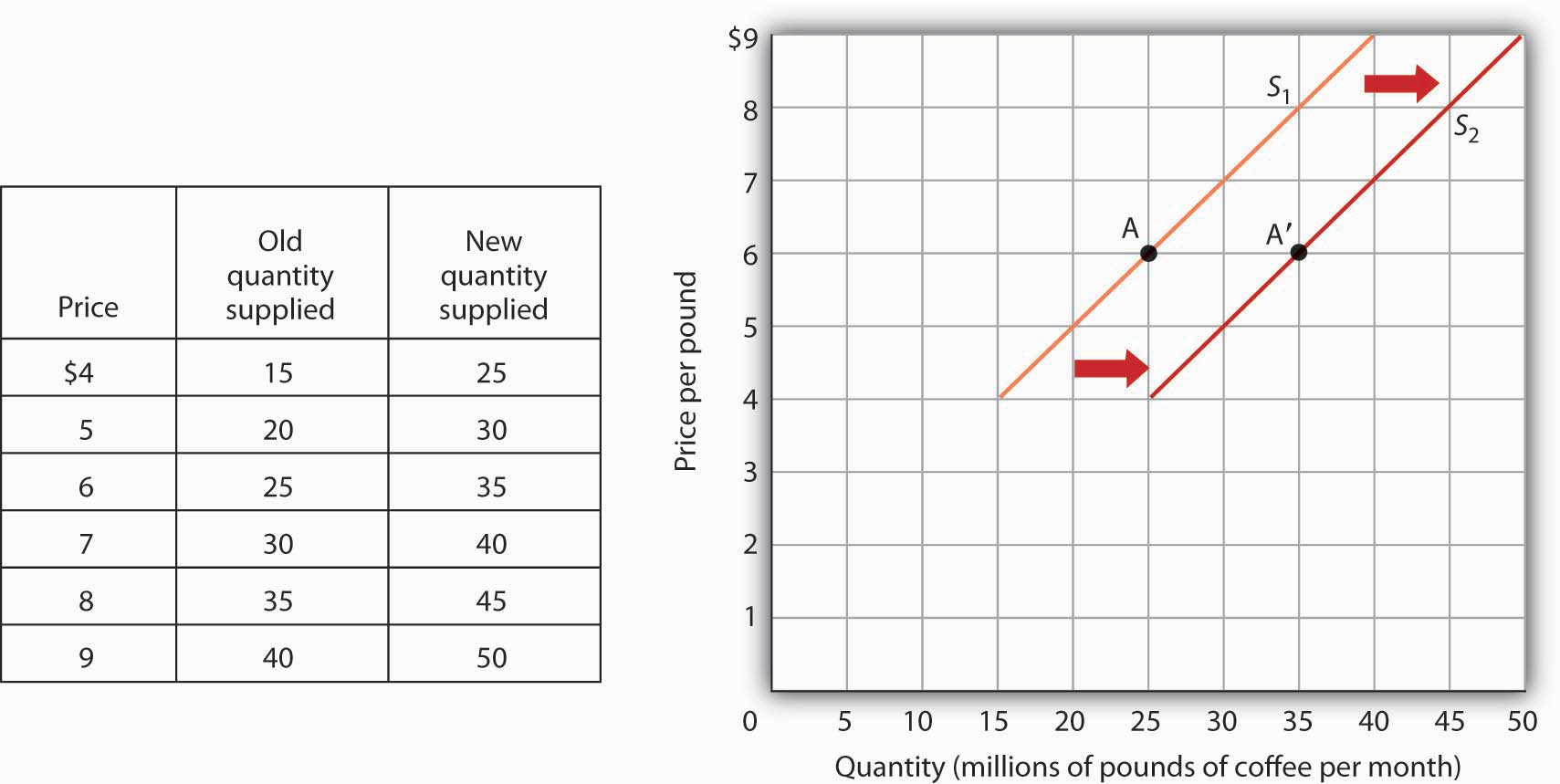
If there is a change in supply that increases the quantity supplied at each price, every bit is the case in the supply schedule here, the supply bend shifts to the right. At a price of $6 per pound, for example, the quantity supplied rises from the previous level of 25 million pounds per month on supply bend S i (point A) to 35 million pounds per month on supply curve S ii (bespeak A′).
An event that reduces the quantity supplied at each cost shifts the supply curve to the left. An increase in production costs and excessive rain that reduces the yields from java plants are examples of events that might reduce supply. Figure 3.10 "A Reduction in Supply" shows a reduction in the supply of java. We encounter in the supply schedule that the quantity of coffee supplied falls by 10 million pounds of coffee per month at each price. The supply curve thus shifts from S 1 to S three.
Effigy 3.10 A Reduction in Supply
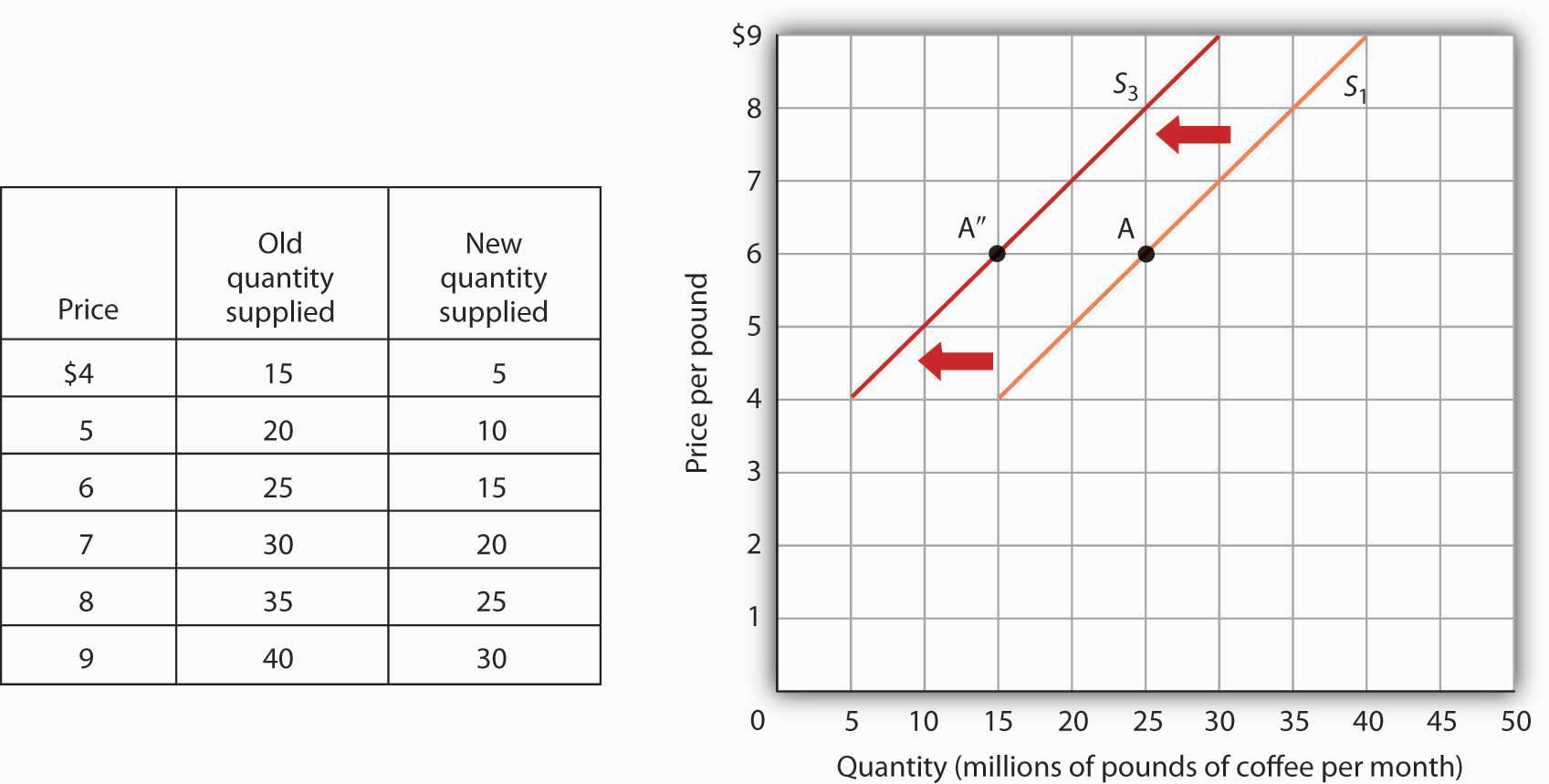
A change in supply that reduces the quantity supplied at each price shifts the supply curve to the left. At a price of $6 per pound, for example, the original quantity supplied was 25 million pounds of java per calendar month (point A). With a new supply curve South 3, the quantity supplied at that price falls to 15 one thousand thousand pounds of java per calendar month (point A″).
A variable that can change the quantity of a good or service supplied at each price is called a supply shifter. Supply shifters include (ane) prices of factors of production, (two) returns from alternative activities, (3) engineering science, (4) seller expectations, (v) natural events, and (6) the number of sellers. When these other variables change, the all-other-things-unchanged conditions behind the original supply curve no longer hold. Let us await at each of the supply shifters.
Prices of Factors of Production
A change in the cost of labor or some other factor of production volition modify the toll of producing whatever given quantity of the proficient or service. This change in the cost of product will change the quantity that suppliers are willing to offer at whatever price. An increase in cistron prices should decrease the quantity suppliers volition offer at whatever price, shifting the supply curve to the left. A reduction in factor prices increases the quantity suppliers will offering at any price, shifting the supply curve to the correct.
Suppose coffee growers must pay a higher wage to the workers they hire to harvest java or must pay more for fertilizer. Such increases in production toll will cause them to produce a smaller quantity at each price, shifting the supply curve for coffee to the left. A reduction in whatsoever of these costs increases supply, shifting the supply curve to the right.
Returns from Alternative Activities
To produce i good or service means forgoing the product of another. The concept of opportunity toll in economics suggests that the value of the activity forgone is the opportunity cost of the activity called; this cost should affect supply. For example, ane opportunity cost of producing eggs is non selling chickens. An increase in the toll people are willing to pay for fresh craven would make information technology more than profitable to sell chickens and would thus increase the opportunity price of producing eggs. It would shift the supply curve for eggs to the left, reflecting a subtract in supply.
Technology
A change in technology alters the combinations of inputs or the types of inputs required in the production procedure. An improvement in applied science usually means that fewer and/or less costly inputs are needed. If the cost of production is lower, the profits available at a given toll will increase, and producers volition produce more. With more produced at every price, the supply curve will shift to the right, pregnant an increase in supply.
Impressive technological changes take occurred in the figurer industry in recent years. Computers are much smaller and are far more powerful than they were merely a few years agone—and they are much cheaper to produce. The consequence has been a huge increase in the supply of computers, shifting the supply curve to the right.
While we usually recollect of technology as enhancing production, declines in product due to problems in engineering are as well possible. Outlawing the use of sure equipment without pollution-control devices has increased the price of production for many goods and services, thereby reducing profits bachelor at any price and shifting these supply curves to the left.
Seller Expectations
All supply curves are based in part on seller expectations about future market weather condition. Many decisions virtually production and selling are typically fabricated long before a product is ready for sale. Those decisions necessarily depend on expectations. Changes in seller expectations tin can have of import effects on price and quantity.
Consider, for case, the owners of oil deposits. Oil pumped out of the ground and used today will be unavailable in the future. If a alter in the international political climate leads many owners to wait that oil prices will rise in the future, they may make up one's mind to leave their oil in the basis, planning to sell it later when the toll is higher. Thus, there volition be a decrease in supply; the supply curve for oil will shift to the left.
Natural Events
Storms, insect infestations, and drought touch on agricultural production and thus the supply of agronomical goods. If something destroys a substantial role of an agricultural crop, the supply curve will shift to the left. The terrible cyclone that killed more than 50,000 people in Myanmar in 2008 likewise destroyed some of the state'due south prime number rice growing land. That shifted the supply curve for rice to the left. If in that location is an unusually good harvest, the supply curve volition shift to the right.
The Number of Sellers
The supply curve for an manufacture, such as java, includes all the sellers in the industry. A alter in the number of sellers in an industry changes the quantity available at each price and thus changes supply. An increase in the number of sellers supplying a good or service shifts the supply curve to the right; a reduction in the number of sellers shifts the supply curve to the left.
The market for cellular phone service has been afflicted by an increase in the number of firms offering the service. Over the by decade, new cellular phone companies emerged, shifting the supply curve for cellular phone service to the right.
Heads Up!
There are two special things to notation about supply curves. The start is similar to the Heads Up! on demand curves: it is important to distinguish carefully between changes in supply and changes in quantity supplied. A change in supply results from a change in a supply shifter and implies a shift of the supply curve to the right or left. A modify in toll produces a change in quantity supplied and induces a movement along the supply curve. A change in price does non shift the supply bend.
The second caution relates to the interpretation of increases and decreases in supply. Detect that in Figure 3.ix "An Increase in Supply" an increase in supply is shown as a shift of the supply curve to the correct; the curve shifts in the direction of increasing quantity with respect to the horizontal axis. In Figure iii.10 "A Reduction in Supply" a reduction in supply is shown equally a shift of the supply curve to the left; the bend shifts in the direction of decreasing quantity with respect to the horizontal centrality.
Because the supply curve is upward sloping, a shift to the correct produces a new curve that in a sense lies "beneath" the original curve. Students sometimes make the mistake of thinking of such a shift as a shift "down" and therefore every bit a reduction in supply. Similarly, it is like shooting fish in a barrel to brand the mistake of showing an increase in supply with a new bend that lies "above" the original curve. Just that is a reduction in supply!
To avert such errors, focus on the fact that an increase in supply is an increase in the quantity supplied at each cost and shifts the supply curve in the direction of increased quantity on the horizontal centrality. Similarly, a reduction in supply is a reduction in the quantity supplied at each cost and shifts the supply curve in the direction of a lower quantity on the horizontal axis.
Figure iii.11
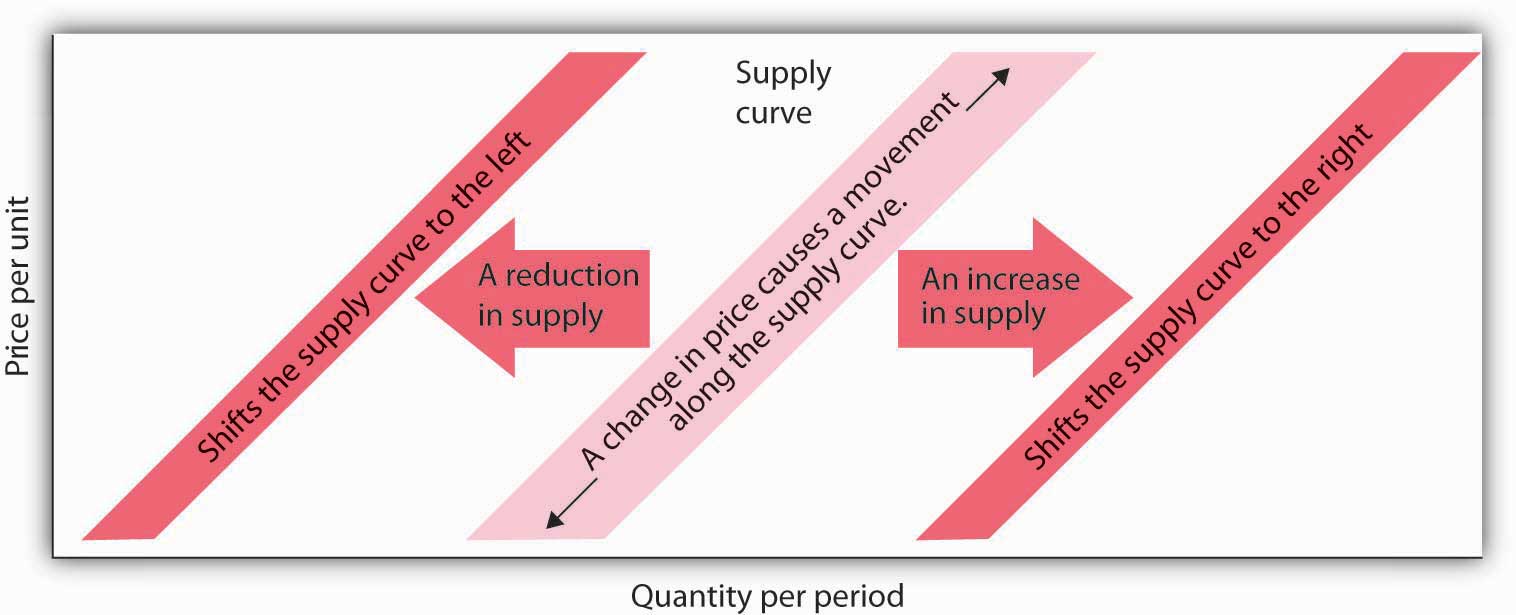
Key Takeaways
- The quantity supplied of a proficient or service is the quantity sellers are willing to sell at a particular price during a detail menses, all other things unchanged.
- A supply schedule shows the quantities supplied at dissimilar prices during a detail menstruation, all other things unchanged. A supply curve shows this same information graphically.
- A alter in the price of a good or service causes a alter in the quantity supplied—a move along the supply curve.
- A change in a supply shifter causes a alter in supply, which is shown as a shift of the supply curve. Supply shifters include prices of factors of production, returns from alternative activities, technology, seller expectations, natural events, and the number of sellers.
- An increase in supply is shown as a shift to the right of a supply curve; a decrease in supply is shown as a shift to the left.
Attempt It!
If all other things are unchanged, what happens to the supply curve for DVD rentals if there is (a) an increment in wages paid to DVD rental shop clerks, (b) an increase in the price of DVD rentals, or (c) an increment in the number of DVD rental stores? Draw a graph that shows what happens to the supply bend in each circumstance. The supply curve tin shift to the left or to the right, or stay where it is. Remember to label the axes and curves, and remember to specify the fourth dimension period (e.g., "DVDs rented per week").
Case in Indicate: The Monks of St. Benedict's Get Out of the Egg Business
Information technology was cookies that lured the monks of St. Bridegroom'due south out of the egg business, and at present private retreat sponsorship is luring them away from cookies.
St. Benedict'southward is a Benedictine monastery, nestled on a ranch loftier in the Colorado Rockies, almost xx miles down the route from Aspen. The monastery's 15 monks operate the ranch to support themselves and to provide help for poor people in the area. They lease out virtually 3,500 acres of their land to cattle and sheep grazers, produce cookies, and sponsor individual retreats. They used to produce eggs.
Attracted by potential profits and the peaceful nature of the work, the monks went into the egg business in 1967. They had ten,000 chickens producing their Monastery Eggs make. For a while, business concern was good. Very skillful. And so, in the tardily 1970s, the price of chicken feed started to rise speedily.
"When we started in the business, nosotros were paying $60 to $80 a ton for feed—delivered," recalls the monastery's abbot, Male parent Joseph Boyle. "By the late 1970s, our cost had more than doubled. We were paying $160 to $200 a ton. That really hurt, because feed represents a large part of the cost of producing eggs."
The monks adjusted to the blow. "When grain prices were lower, we'd pull a hen off for a few weeks to molt, then return her to laying. Afterward grain prices went up, information technology was 12 months of laying and into the soup pot," Father Joseph says.
Grain prices continued to rising in the 1980s and increased the costs of production for all egg producers. It caused the supply of eggs to fall. Demand fell at the aforementioned time, as Americans worried about the cholesterol in eggs. Times got tougher in the egg business.
"We were still making coin in the financial sense," Begetter Joseph says. "Simply we tried an experiment in 1985 producing cookies, and information technology was a success. We finally decided that devoting our fourth dimension and free energy to the cookies would pay off better than the egg business organisation, so we quit the egg business in 1986."
The mail-guild cookie business was practiced to the monks. They sold 200,000 ounces of Monastery Cookies in 1987.
Past 1998, however, they had limited their production of cookies, selling only locally and to souvenir shops. Since 2000, they take switched to "providing private retreats for individuals and groups—nigh 40 people per calendar month," according to Brother Charles.
The monks' adding of their opportunity costs revealed that they would earn a higher return through sponsorship of private retreats than in either cookies or eggs. This projection has proved correct.
And in that location is another advantage as well.
"The chickens didn't terminate laying eggs on Sunday," Father Joseph chuckles. "When we shifted to cookies we could have Sundays off. We weren't hemmed in the way nosotros were with the chickens." The motion to providing retreats is even better in this regard. Since guests provide their ain meals, most of the monastery'due south try goes into planning and scheduling, which frees upwardly even more of their time for other worldly equally well every bit spiritual pursuits.
Source: Personal interviews.
Answer to Try Information technology! Trouble
DVD rental store clerks are a factor of product in the DVD rental marketplace. An increment in their wages raises the cost of product, thereby causing the supply curve of DVD rentals to shift to the left [Console (a)]. (Caution: Information technology is possible that you thought of the wage increase as an increase in income, a demand shifter, that would lead to an increase in demand, but this would exist incorrect. The question refers only to wages of DVD rental store clerks. They may rent some DVD, but their impact on total need would be negligible. Besides, we have no information on what has happened overall to incomes of people who rent DVDs. We do know, however, that the cost of a factor of production, which is a supply shifter, increased.)
An increase in the price of DVD rentals does not shift the supply curve at all; rather, it corresponds to a motility upward to the correct forth the supply curve. At a higher price of P 2 instead of P 1, a greater quantity of DVD rentals, say Q 2 instead of Q 1, will be supplied [Panel (b)].
An increase in the number of stores renting DVDs volition cause the supply curve to shift to the right [Panel (c)].
Figure 3.13
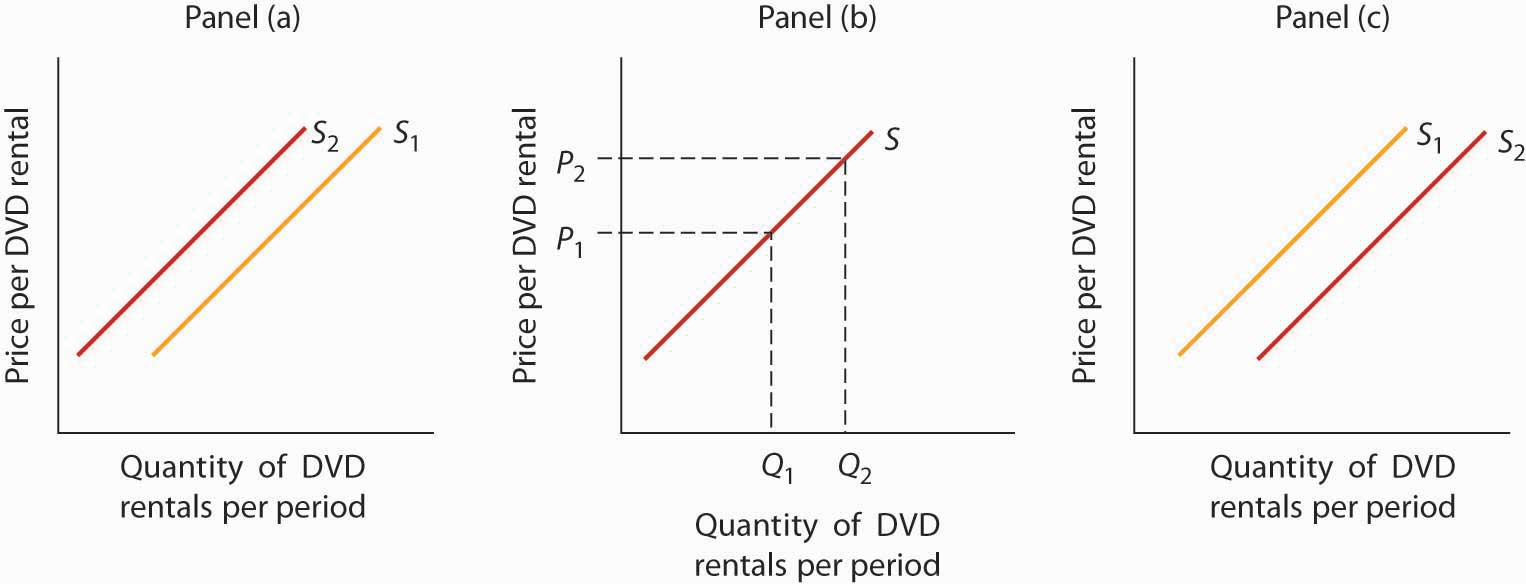
withersfartandence.blogspot.com
Source: https://open.lib.umn.edu/principleseconomics/chapter/3-2-supply/
0 Response to "what causes a supply curve to shift left"
Post a Comment